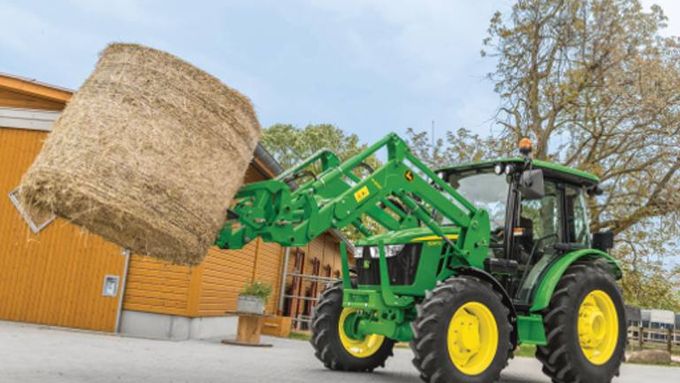Common problems with the John Deere 5100E include hydraulic issues, electrical failures, and engine performance concerns. Regular maintenance helps mitigate these issues effectively.
The John Deere 5100E is a versatile utility tractor, popular among farmers and landscapers. Despite its reliability, users often encounter specific problems that can affect performance. Hydraulic system failures can lead to inefficient operation, while electrical issues may cause starting problems.
Engine performance can also decline due to fuel system clogging or poor maintenance. Understanding these common issues is essential for owners to ensure smooth operation and longevity. Regular check-ups and prompt repairs can prevent minor problems from escalating into significant challenges, ensuring your tractor remains a valuable asset on the field.

Credit: www.weingartz.com
Introduction To John Deere 5100e
The John Deere 5100E is a popular tractor among farmers. It is known for its efficiency and versatility. However, some users have reported problems. Understanding its features helps in troubleshooting these issues.
A Brief Overview
The John Deere 5100E belongs to the E Series. This series is designed for small to medium farms. The tractor offers:
- 100 horsepower
- Four-wheel drive
- Hydraulic capacity of 2,900 psi
- Compact design for easy maneuverability
It is equipped with a powerful engine. Operators enjoy its ease of use and comfort. The spacious cabin provides a great working environment. Many appreciate the fuel efficiency of this model.
Why It Stands Out
The John Deere 5100E stands out for several reasons:
- Durability: Built to withstand tough conditions.
- Versatility: Suitable for various tasks like plowing and hauling.
- Maintenance: Easy access to parts for repairs.
Its ergonomic design enhances operator comfort. This tractor is an excellent choice for small farms. Users find it reliable and efficient in their daily tasks.

Credit: www.farmertechy.com
Common Issues With The 5100e
The John Deere 5100E is a reliable tractor. Yet, like all machines, it has its share of problems. Understanding these common issues can help you troubleshoot effectively. Here are the most frequent problems owners face.
Electrical Hiccups
Electrical issues can disrupt the performance of the 5100E. Common electrical hiccups include:
- Battery Drain: The battery may lose charge quickly.
- Faulty Wiring: Damaged wires can lead to failures.
- Blown Fuses: Frequent fuse issues can cause malfunctions.
Check the following to resolve electrical problems:
- Inspect the battery connections.
- Look for signs of damaged wiring.
- Replace any blown fuses.
Hydraulic System Faults
The hydraulic system is crucial for the 5100E’s operation. Problems in this system can affect performance. Common hydraulic faults include:
- Fluid Leaks: Check for leaks around hoses and connections.
- Poor Lift Performance: The loader may not lift properly.
- Noisy Operation: Unusual sounds may indicate issues.
To maintain the hydraulic system:
- Regularly check fluid levels.
- Inspect hoses for wear and tear.
- Ensure all connections are tight.
Addressing these common issues can enhance the performance of your John Deere 5100E.
Troubleshooting Electrical Problems
Troubleshooting electrical problems in the John Deere 5100E can be crucial. Issues may lead to frustration and downtime. Knowing common electrical problems helps you act quickly.
Starting Issues
Starting problems can occur with the John Deere 5100E. The engine may not turn over for several reasons:
- Weak battery: Check for corrosion on terminals.
- Faulty ignition switch: Ensure it functions properly.
- Starter motor issues: Test the starter for proper operation.
Follow these steps for effective troubleshooting:
- Inspect the battery voltage.
- Clean battery terminals.
- Test the ignition switch with a multimeter.
- Check wiring connections to the starter motor.
Battery Draining Fast
A rapidly draining battery can create major headaches. Here are common causes:
- Parasitic drain: Find devices using power when off.
- Faulty alternator: Verify that it charges the battery.
- Old battery: Consider replacing it if it’s over three years old.
To diagnose the issue:
- Use a multimeter to check battery voltage.
- Inspect all electrical components.
- Test the alternator output.
Keep your battery in good shape. Regular maintenance helps prevent issues.
Addressing Hydraulic System Concerns
The hydraulic system in the John Deere 5100E is crucial for performance. Issues can affect productivity and cause frustration. Understanding these problems helps in quick fixes.
Weak Fluid Flow
Weak fluid flow often leads to poor performance. This issue can stem from several causes:
- Low hydraulic fluid levels
- Clogged filters
- Damaged hoses
- Faulty pump
Check the hydraulic fluid regularly. Ensure the fluid is clean and at the proper level. Replace any clogged filters to restore flow.
Leaks And Pressure Loss
Leaks and pressure loss can severely impact the hydraulic system. Look for these signs:
- Visible fluid puddles
- Decreased lifting power
- Unusual noises from the system
Common causes include:
- Worn seals or gaskets
- Punctured hoses
- Loose fittings
Inspect all connections. Tighten any loose fittings to prevent leaks. Replace worn or damaged parts promptly.
Transmission Troubles
The John Deere 5100E is known for its durability. However, many owners face transmission issues. These problems can lead to frustration and downtime. Understanding common transmission troubles helps in maintaining your tractor’s performance.
Hard Shifting
Hard shifting occurs when gears do not engage smoothly. This issue can stem from several factors:
- Low Transmission Fluid: Insufficient fluid can cause resistance.
- Worn Clutch: A damaged clutch affects gear engagement.
- Faulty Linkages: Misaligned or damaged linkages can hinder shifting.
To troubleshoot hard shifting:
- Check the transmission fluid level.
- Inspect the clutch for wear.
- Examine linkages for damage or misalignment.
Unusual Noises
Unusual noises during operation can signal problems. Common sounds include:
| Noise Type | Possible Cause |
|---|---|
| Grinding | Worn gears or low fluid levels |
| Clunking | Loose components or damaged linkages |
| Whining | Faulty bearings or insufficient lubrication |
Addressing these noises is crucial. Regular maintenance can prevent severe issues. Always consult your manual for proper troubleshooting steps.

Credit: www.hutsoninc.com
Engine Performance Issues
Engine performance problems can affect the efficiency of your John Deere 5100E. Identifying these issues early can save time and money. Two common problems are overheating and power loss. Let’s explore these issues in detail.
Overheating
Overheating is a major concern for many tractor owners. It can lead to serious engine damage. Here are some common causes:
- Low coolant levels
- Clogged radiator
- Faulty thermostat
- Poor airflow
Signs of overheating include:
- High temperature gauge readings
- Steam from the engine
- Loss of power
To prevent overheating:
- Check coolant regularly.
- Inspect the radiator for blockages.
- Ensure proper airflow around the engine.
Power Loss
Power loss is another common issue. It can impact work performance significantly. Several factors contribute to power loss:
| Cause | Description |
|---|---|
| Fuel Issues | Dirty fuel filters can restrict fuel flow. |
| Air Filter Blockage | A clogged air filter limits airflow to the engine. |
| Injector Problems | Faulty fuel injectors can cause uneven performance. |
Check for these signs of power loss:
- Engine sputtering
- Slow acceleration
- Unusual engine noises
Regular maintenance helps prevent power loss. Change filters and inspect fuel systems frequently.
Preventive Maintenance Tips
Keeping your John Deere 5100E in top shape is crucial. Regular maintenance can prevent costly repairs. Here are some practical tips to help you maintain your tractor effectively.
Regular Checks
Conducting regular checks ensures your tractor runs smoothly. Focus on these key areas:
- Fluid Levels: Check oil, coolant, and hydraulic fluid levels.
- Tires: Inspect tire pressure and tread wear.
- Battery: Clean terminals and check charge levels.
- Filters: Replace air and fuel filters regularly.
- Belts and Hoses: Look for signs of wear and tear.
Recommended Practices
Adopting these practices can enhance your tractor’s longevity:
- Follow the Manual: Always refer to the owner’s manual.
- Schedule Regular Servicing: Plan for professional inspections.
- Use Quality Parts: Always use OEM parts for replacements.
- Keep it Clean: Regularly wash the tractor to prevent rust.
- Store Properly: Keep the tractor in a dry, covered area.
Implement these tips to avoid common John Deere 5100E problems. A little effort now can save big later.
Professional Help Vs. Diy
Owning a John Deere 5100E can be rewarding. Yet, it comes with challenges. Understanding when to seek professional help or tackle repairs yourself is crucial. Both options have benefits and drawbacks. Knowing these will save time and money.
When To Call An Expert
Some problems require professional expertise. Ignoring serious issues can lead to bigger repairs. Here are signs to call an expert:
- Engine Problems: Unusual noises or smoke.
- Hydraulic Issues: Weak or erratic movement.
- Electrical Failures: Lights not working or starting issues.
- Complex Repairs: Major component failures.
Experts can diagnose issues quickly. They have tools and experience. This often prevents further damage.
Resources For Diy Repairs
Many minor repairs can be done yourself. This saves money and enhances skills. Here are resources to help:
- Owner’s Manual: Provides detailed instructions.
- Online Forums: Connect with other owners.
- YouTube Tutorials: Visual guides for repairs.
- Local Workshops: Hands-on training opportunities.
Before starting repairs, assess your skill level. Ensure you have the right tools. Some common DIY tasks include:
| Task | Tools Needed | Skill Level |
|---|---|---|
| Oil Change | Wrench, Oil Filter | Beginner |
| Battery Replacement | Wrench, Safety Gloves | Beginner |
| Filter Replacement | Wrench, New Filter | Intermediate |
Always prioritize safety. Wear protective gear. Follow proper procedures. This ensures successful repairs and keeps you safe.
Frequently Asked Questions
What Are Common John Deere 5100e Issues?
Common issues include engine starting problems, hydraulic failures, and electrical system malfunctions.
How To Troubleshoot John Deere 5100e Problems?
Start by checking the battery, fuses, and fluid levels. Refer to the manual for specific troubleshooting steps.
What Causes Hydraulic Issues In John Deere 5100e?
Hydraulic problems can stem from low fluid levels, leaks, or faulty pumps and valves.
How To Maintain A John Deere 5100e?
Regularly check fluids, change filters, and inspect belts and hoses to keep the tractor in top shape.
Where To Find Parts For John Deere 5100e?
Parts are available at authorized dealers, online marketplaces, and specialty tractor supply stores.
Conclusion
Addressing John Deere 5100E problems is essential for maintaining your tractor’s performance. Regular maintenance and timely repairs can prevent minor issues from escalating. Stay informed about common challenges and solutions. This proactive approach ensures your equipment runs smoothly, maximizing efficiency and productivity on your farm or job site.
Keep your tractor in top shape!
